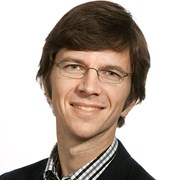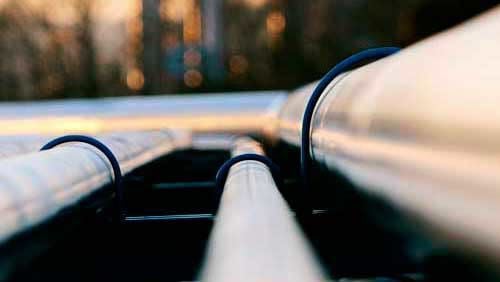When design of such pipeline networks for CO2, engineers need to be able to perform calculations regarding safety and operation. For instance, a possible leak of CO2 will cause a strong cooling of the pipe, which may cause the pipe material to become brittle and to crack. It is desirable to avoid this.
To perform such calculations, one needs models for multiphase flow (that is, the flow of gases and liquids), and these models need to describe not only the transport, but also pressure waves, for the pressure contributes to determine the temperature. Such models are not an off-the-shelf commodity today.
One important aspect of depressurizations of CO2 pipelines is the wave-propagation speed, or the speed of sound. To calculate it, one needs both a flow model and a thermodynamic model. Work in this project has shown that the speed of sound is dependent on, among other things, the assumptions made about phase equilibrium, that is, whether or not evaporation and condensation happen instantaneously.
The project has developed a numerical model for the calculation of single and multiphase flow of CO2 and CO2-rich mixtures in pipes. The model has been employed to calculate a depressurization of a full-scale CO2-transport pipeline.
Two PhD candidates have been working in the project. One studied flow models and the other studies thermodynamic models, especially for CO2-water mixtures.
CO2 Dynamics has achieved three main results:
- Improved basic understanding of CO2 transport, which will be of use for future CCS projects
- Educated two PhD candidates, who will contribute to improving the competence in industry or in research
- A combined flow and thermodynamic model which can calculate CO2 flow in pipes, and which can be employed to study the effect of different sub-models and parameters.
Publications:
Journal articles
- Munkejord, S. T. and Hammer, M.
Depressurization of CO2-rich mixtures in pipes: Two-phase flow modelling and comparison with experiments.
International Journal of Greenhouse Gas Control, vol. 37, pp. 398-411, June 2015. - Lund, H., Müller, F., Müller, B. and Jenny, P.
Rankine-Hugoniot-Riemann solver for steady multidimensional conservation laws with source terms.
Computers & Fluids, vol. 101, pp. 1-14, September 2014. - Hammer, M. and Morin, A.
A method for simulating two-phase pipe flow with real equations of state.
Computers & Fluids, vol. 100, pp. 45-58, September 2014. - Ibrahim, M., Skaugen, G., Ertesvåg, I. S. and Haug-Warberg, T.
Modelling CO2-water mixture thermodynamics using various equations of state (EoSs) with emphasis on the potential of the SPUNG EoS.
Chemical Engineering Science, vol. 113, pp. 22-34, July 2014. - Aursand, P., Evje, S., Flåtten, T., Giljarhus, K. E. T., and Munkejord, S. T.
An exponential time-differencing method for monotonic relaxation systems.
Applied Numerical Mathematics, vol. 80, pp. 1-21, June 2014. - Aursand, P. and Flåtten, T.
On the dispersive wave-dynamics of 2 x 2 relaxation systems.
Journal of Hyperbolic Differential Equations, vol. 9, no. 4, pp. 641–659, December, 2012. - Lund, H.
A hierarchy of relaxation models for two-phase flow.
SIAM Journal on Applied Mathematics, vol. 72, no. 6, pp. 1713–1741, December 2012. - Flåtten, T. and Morin, A.
On interface transfer terms in two-fluid models.
International journal of Multiphase Flow, vol. 45, pp. 24-29, October 2012. - Martínez Ferrer, P. J., Flåtten, T. and Munkejord, S. T.
On the effect of temperature and velocity relaxation in two-phase flow models.
ESAIM: Mathematical Modelling and Numerical Analysis, vol. 46, no. 2, pp. 411-442, March 2012. - Flåtten, T. and Lund, H.
Relaxation two-phase flow models and the subcharacteristic condition.
Mathematical Models and Methods in Applied Sciences, vol. 21, no. 12, pp. 2379-2407, December, 2011. - Li, H., Wilhelmsen, Ø., Lv, Y., Wang, W., Yan, J.
Viscosity, thermal conductivity and diffusion coefficients of CO2 mixtures: review of experimental data and theoretical models.
International Journal of Greenhouse Gas Control, vol. 5, no. 5, pp. 1119-1139, September 2011. - Flåtten, T., Morin, A. and Munkejord, S. T.
On solutions to equilibrium problems for systems of stiffened gases.
SIAM Journal on Applied Mathematics, vol. 71, no. 1, pp. 41-67, January 2011. - Flåtten, T., Morin, A. and Munkejord, S. T.
Wave propagation in multicomponent flow models.
SIAM Journal on Applied Mathematics, vol. 70, no. 8, pp. 2861-2882, September 2010. - Munkejord, S. T., Jakobsen, J. P., Austegard, A. and Mølnvik, M. J.
Thermo- and fluid-dynamical modelling of two-phase multi-component carbon dioxide mixtures.
International Journal of Greenhouse Gas Control, vol. 4, no. 4, pp. 589-596, July 2010.
Conference proceedings
- Drescher, M., Varholm, K., Munkejord, S. T., Hammer, M., Held, R. and de Koeijer, G.
Experiments and modelling of two-phase transient flow during pipeline depressurization of CO2 with various N2 compositions.
In: GHGT-12, 12th International Conference on Greenhouse Gas Control Technologies, University of Texas at Austin / IEAGHG, Austin, Texas, USA, 5–9 October 2014. Energy Procedia, vol. 63, pp. 2448-2457, 2014. - Aakenes, F., Munkejord, S. T. and Drescher, M.
Frictional pressure drop for two-phase flow of carbon dioxide in a tube: Comparison between models and experimental data. In: 7th Trondheim CCS Conference (TCCS-7), 5–6 June 2013. Energy Procedia, vol. 51, pp. 373-381, 2014. Paper and Poster. - Ibrahim, M., Skaugen, G. and Ertesvåg, I. S.
Modelling CO2-water thermodynamics using SPUNG equation of state (EOS) concept with various reference fluids. In: 7th Trondheim CCS Conference (TCCS-7), 5–6 June 2013. Energy Procedia, vol. 51, pp. 353-362, 2014. - Munkejord, S.T., Bernstone, C., Clausen, S., de Koeijer, G. and Mølnvik, M. J.
Combining thermodynamic and fluid flow modelling for CO2 flow assurance.
In: GHGT-11, 11th International Conference on Greenhouse Gas Control Technologies, IEAGHG / RITE, Kyoto, Japan, November 2012. Energy Procedia, vol. 37, pp. 2904-2913, 2013. - Lund, H. and Aursand, P.
Splitting methods for relaxation two-phase flow models.
In: ECCOMAS YIC2012, First European Community on Computational Methods in Applied Sciences (ECCOMAS) Young Investigators Conference, Aveiro, Portugal, April 2012. International Journal of Materials Engineering Innovation, vol. 4, no. 2, pp. 117–131, 2013. - Ibrahim, M., Skaugen, G. and Ertesvåg, I. S.
Preliminary evaluation of the SPUNG equation of state for modelling the thermodynamic properties of CO2-water mixtures.
In: 2nd Trondheim Gas Technology Conference, NTNU / SINTEF, Trondheim, Norway, November 2011. Energy Procedia, vol. 26, pp. 90-97, 2012. - Clausen, S. and Munkejord, S.T.
Depressurization of CO2 - a numerical benchmark study.
In: 6th Trondheim Conference on CO2 Capture, Transport and Storage (TCCS-6), BIGCCS / SINTEF / NTNU, Trondheim, Norway, June 2011. Energy Procedia, vol. 23, pp. 2984-2991, 2012. Paper and Poster. - Lund, H. and Aursand, P.
Two-phase flow of CO2 with phase transfer.
In: 6th Trondheim Conference on CO2 Capture, Transport and Storage (TCCS-6), BIGCCS / SINTEF / NTNU, Trondheim, Norway, June 2011. Energy Procedia, vol. 23, pp. 246-255, 2012. - Wilhelmsen, Ø., Skaugen, S., Jørstad, O. and Li, H.
Evaluation of SPUNG and other equations of state for carbon capture and storage modelling.
In: 6th Trondheim Conference on CO2 Capture, Transport and Storage (TCCS-6), BIGCCS / SINTEF / NTNU, Trondheim, Norway, June 2011. Energy Procedia, vol. 23, pp. 236-245, 2012. - Lund, H., Flåtten, T. and Munkejord, S.T.
Depressurization of carbon dioxide in pipelines - models and methods.
In: GHGT-10, 10th International Conference on Greenhouse Gas Control Technologies, IEAGHG, Amsterdam, The Netherlands, September 2010. Energy Procedia, vol. 4, pp. 2984-2991, 2011. Paper and Poster. - Lund, H. and Flåtten, T.
Equilibrium conditions and sound velocities in two-phase flows.
Presented at SIAM Annual Meeting (AN10), Pittsburgh, Pennsylvania, USA, 12-16 July, 2010. - Morin, A., Aursand, P. K., Flåtten, T. and Munkejord, S. T.
Numerical resolution of CO2 transport dynamics.
Presented at SIAM Conference on Mathematics for Industry: Challenges and Frontiers (MI09), San Francisco, California, USA, October 2009. - Munkejord, S. T., Jakobsen, J. P., Austegard, A. and Mølnvik, M. J.
Thermo- and fluid-dynamical modeling of two-phase multi-component carbon dioxide mixtures.
In: GHGT-9, 9th International Conference on Greenhouse Gas Control Technologies, MIT / IEA GHG, Washington DC, USA, November 2008. Energy Procedia vol. 1, no. 1, pp. 1649-1656, February 2009. Paper and Poster.
PhD theses
- Lund, H.
Relaxation models for two-phase flow with applications to CO2 transport.
PhD thesis, Dept. of Energy and Process Engineering, Norwegian University of Science and Technology (NTNU), August 2013.
Master's theses
- Aakenes, F.
Frictional pressure-drop models for steady-state and transient two-phase flow of carbon dioxide.
Master's thesis, Dept. of Energy and Process Engineering, Norwegian University of Science and Technology (NTNU), June 2012. - Aursand, P. K.
Hyperbolic conservation laws with relaxation terms — A theoretical and numerical study.
Master's thesis, Dept. of Physics, Norwegian University of Science and Technology (NTNU), June 2011. - Martínez Ferrer, P. J.
Numerical and mathematical analysis of a five-equation model for two-phase flow.
Master's thesis / internship report, SINTEF Energy Research, Trondheim, Norway, October 2010.
Project partners:
Industry partners: Gassco AS, Statoil Petroleum AS and Vattenfall Research and Development AB
Research-performing partners: SINTEF Energy Research and NTNU

